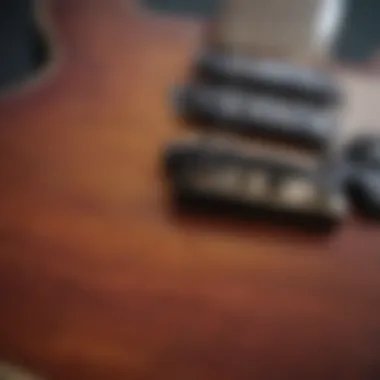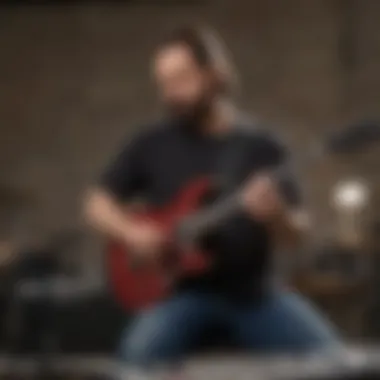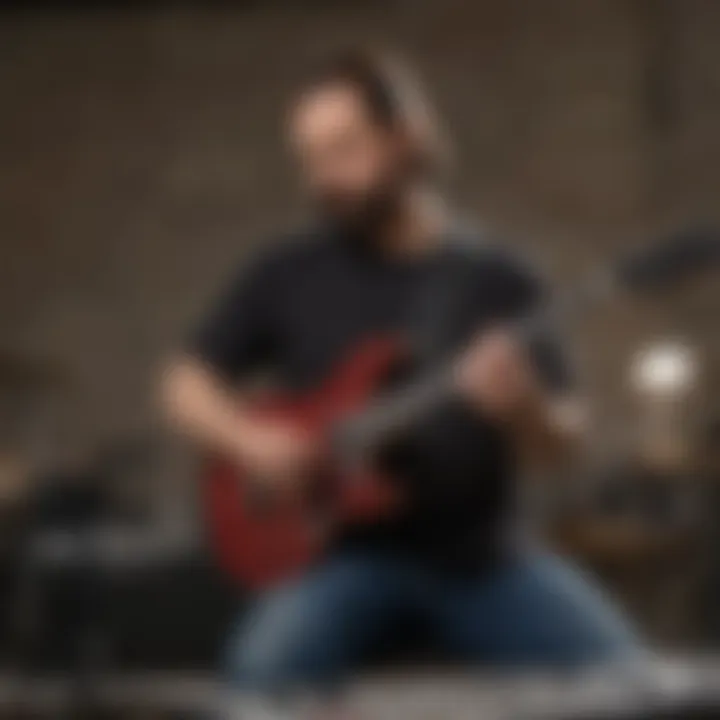The Majesty of John Petrucci: A Comprehensive Exploration


Intro
John Petrucci stands as a towering figure in the landscape of contemporary music. He is best known for his virtuosic guitar skills, intricate compositions, and profound influence on the progressive rock and metal genres. This systematic exploration seeks to unravel the layers of his artistry, shedding light on his biography, major influences, and his remarkable output as both a musician and educator. By delving deeply into the nuances of his work, this article aims to serve as a detailed guide for music enthusiasts, aspiring musicians, and students.
Artist Profile
Biography and Background
John Petrucci was born on July 12, 1967, in Kings Park, New York. From an early age, his environment fostered a love for music. He began playing the guitar at age twelve, an interest that rapidly evolved into a deep commitment to mastering the instrument. In 1985, he co-founded the band Dream Theater, a pivotal act in progressive metal. Petrucci's impeccable technique quickly set him apart in the music community.
His education at the Berklee College of Music further shaped his complex musical style. At Berklee, he had access to advanced music theory and diverse genres, which allowed him to refine his craft. Petrucci has not only built a reputation as a guitarist but has also made significant contributions as a composer and producer.
Major Influences and Inspirations
Petrucci's musical style draws from a variety of influences. Notable inspirations include:
- Steve Vai: Known for his innovative techniques and creativity.
- Joe Satriani: A master of melodic structure and emotional expression.
- Rush: The band's progressive elements and sophisticated compositions have left a lasting impression.
- Metallica: Their aggressive sound and intricate songwriting influenced many aspiring metal guitarists, including Petrucci.
In addition, classical music, especially composers like Johann Sebastian Bach, has shaped his songwriting and compositional technique. Petrucci consistently integrates complex guitar arrangements into his work, reflecting his diverse influences.
Song Analysis
Theme and Lyrics Breakdown
Dream Theater's songs, largely penned by Petrucci, often feature profound themes. They explore human emotions, existential questions, and personal struggles. For instance, the piece "Metropolis—Part I: The Miracle and the Sleeper" combines intricate storytelling with rich musical landscapes, making it a signature piece that showcases both lyrical depth and complex arrangements.
Instrumentation and Composition
Petrucci's compositions are characterized by a blend of heavy riffs and intricate melodies. He utilizes a range of instruments and effects to create his sound. Notably, his choice of equipment includes:
- Ernie Ball Music Man guitars: Customized for superior performance.
- Mesa/Boogie amplifiers: Known for their tonal richness and clarity.
- High-quality effects pedals to enhance his sound palette.
These elements contribute to the signature sound of not only his solo work but also Dream Theater's catalog.
"Guitar playing is not just about technique; it's about conveying emotion through the instrument." – John Petrucci
Finale
The artistry of John Petrucci is a study in complexity and creativity. His contributions have reshaped the music industry, particularly in progressive rock and metal. By understanding his influences, compositions, and the evolution of his signature style, musicians and fans alike can gain valuable insights into the mind of one of the genre's most influential figures.
For further exploration, readers can visit resources such as Wikipedia on John Petrucci, or engage with the community on platforms like Reddit.
This article serves as a comprehensive guide to understanding John Petrucci's remarkable contributions to music, effective for both musicians and music enthusiasts.
Preamble to John Petrucci
The position of John Petrucci in the music industry stands as a testament to his skill, dedication, and influence as a guitarist and composer. This section is essential as it sets the stage for understanding Petrucci’s contributions within the realms of progressive rock and metal. As a founding member of Dream Theater, Petrucci has shaped the sound of modern progressive music and has become a role model for many aspiring musicians.
His background, his rise from humble beginnings, and his relentless pursuit of excellence provide a comprehensive insight into his artistry. Further exploration of Petrucci's early life reflects not just his musical journey but also the cultural contexts that shaped his perspective as a musician.
In this article, details such as his formative years, the genesis of Dream Theater, and his ongoing influence will be dissected. With each element considered, readers can appreciate the depth of Petrucci’s artistry and the legacy he continues to build within the music world.
Early Life and Musical Beginnings
John Petrucci was born on July 12, 1967, in Kings Park, New York. His passion for music began at a young age. He started playing the guitar at around the age of twelve. Initially, he was influenced by rock music, with musicians such as Jimmy Page and Ritchie Blackmore sparking his interest. As he explored various genres, his appreciation for intricate playing and complex structures deepened.
Petrucci attended the Berklee College of Music, where he refined his guitar techniques and composition skills. The rigorous curriculum exposed him to diverse musical styles and theoretical knowledge. Berklee also played a crucial role in shaping his musical philosophy. During this time, he developed his signature sound, characterized by technical proficiency combined with melodic sensibility.
Formation of Dream Theater
The pivotal moment in Petrucci’s career came with the formation of Dream Theater in 1985. Along with bassist John Myung and drummer Mike Portnoy, Petrucci founded the group after meeting during their time at Berklee. Their shared passion for music quickly sparked a creative collaboration that resulted in the blend of heavy metal and progressive rock that Dream Theater is known for.
Dream Theater’s self-titled debut album released in 1993, showcased a groundbreaking fusion of styles, intricate guitar solos, and complex song structures. The band’s unique approach set a new standard for progressive metal, earning them a loyal fan base and critical acclaim.
“The music we create is a reflection of our identity and influences.”


Petrucci’s role as the lead guitarist and primary songwriter was instrumental to the band’s success. His ability to weave emotional depth into intricate compositions has not only defined Dream Theater's sound but has also influenced countless musicians across genres.
Through this exploration of Petrucci’s early life and the formation of Dream Theater, one can gain insight into the foundations of his artistic endeavors and the path that led to his becoming a standout figure in the music industry.
Musical Influences and Inspirations
John Petrucci's profound impact on progressive rock is deeply tied to the musical influences that shaped his development as a guitarist and composer. Understanding these influences offers valuable insight into his artistry. This section explores his key inspirations, which combine elements from diverse genres to form his unique sound. Acknowledging these influences enhances one's appreciation of his work and serves as a guide for aspiring musicians.
Key Influences from Rock and Metal
John Petrucci's foundation in rock and metal can be traced back to iconic guitarists such as Jimmy Page, Eric Clapton, and Tony Iommi. Their innovative approaches to guitar playing contributed significantly to the style Petrucci would later develop. The aggressive riffs and intricate solos in heavy metal provide a framework within which his technical skills flourished.
- Riff Construction: Petrucci often employs complex, palm-muted riffs reminiscent of Metallica or Slayer. This enables him to deliver powerful energy in his music.
- Guitar Tone: The crisp sound associated with rock guitarists is evident in Petrucci's work, achieved through meticulous choice of gear and amplification.
- Soloing Style: Influenced by artists like Yngwie Malmsteen, Petrucci frequently utilizes fast, melodic solo lines that encapsulate the essence of neoclassical metal.
In interviews, Petrucci has stated the importance of these influences in shaping his abilities. He mentions that mimicking these legends helped him develop his musical ear and technique, which are crucial for any guitarist.
Inspiration from Classical Music
While primarily known for his work in rock and metal, Petrucci also draws inspiration from classical music. This influence is evident in the complexity and compositional techniques present in his writing. Artists such as Bach and Vivaldi have left a lasting mark on his musical style.
- Intervals and Progressions: Petrucci's compositions often feature intricate chord progressions and harmonic structures, demonstrating a deep understanding of musical theory.
- Melodic Construction: Many of Petrucci’s melodies exhibit classical traits; they can be lyrical and emotive, resembling pieces from orchestral works.
- Timing and Nuance: He incorporates various time signatures and rhythmic complexities found in classical compositions, setting his work apart from standard rock music.
"The fusion of classical elements creates a richness in my music that resonates with both the technical and emotional aspects of playing."
This blending of styles not only adds depth to Petrucci's catalog but also serves as a benchmark for modern musicians seeking to incorporate diverse influences into their work. It invites musicians to explore their own inspirations, fostering a broader understanding of music.
Understanding Petrucci's influences allows both music enthusiasts and aspiring musicians to dissect his work and appreciate the broader context it operates within. Engaging with this knowledge provides a roadmap for personal musical evolution.
Signature Guitar Techniques
Signature guitar techniques are critical to understanding the artistry of John Petrucci. They embody his unique style, which blends technical precision with expressive musicality. By mastering these techniques, musicians not only elevate their playing but also gain deeper insight into the creative process of one of the genre’s most revered guitarists.
Petrucci's approach involves an array of methods that contribute to his signature sound. These techniques are characterized by their complexity and require both skill and dexterity. They also set a high standard for aspiring musicians. In this section, we delve into two key aspects of his technique: alternate picking and tapping, followed by the use of harmonics and the whammy bar.
Alternate Picking and Tapping
Alternate picking is a technique that involves striking the strings with alternating downstrokes and upstrokes. This method is essential for achieving speed and clarity in performance. John Petrucci utilizes alternate picking not only for fast passages but also for more subtle melodic lines.
Tapping, on the other hand, allows for quick, fluid note sequences that would be challenging to execute with traditional picking methods alone. Petrucci is known for his use of two-handed tapping, where both hands play notes on the fretboard. This not only increases the speed of his playing but also adds depth to his solos. By practicing these techniques consistently, musicians can enhance their agility and creative expression.
Use of Harmonics and Whammy Bar
Harmonics are another crucial aspect of John Petrucci's playing. They create a bell-like tone that adds texture to his music. Petrucci employs natural harmonics and artificial harmonics, showcasing his command over the guitar. Understanding how to produce these sounds enriches a musician's palette, allowing them to introduce new layers into their compositions.
The whammy bar, or tremolo arm, gives guitarists the ability to bend pitch dramatically. Petrucci's use of the whammy bar enhances his expressive capabilities. It allows for dramatic pitch shifts that can evoke a strong emotional response in the listener. This technique, when used judiciously, can transform ordinary notes into something extraordinary.
"The techniques that define a guitarist often become a part of their identity, shaping how they connect with their audience and express their musical ideas."
In summary, John Petrucci's techniques, such as alternate picking, tapping, and the use of harmonics and whammy bar, represent hallmark elements of his artistic expression. For aspiring musicians and enthusiasts, understanding and practicing these techniques can be immensely beneficial in their own musical journeys.
Discography Overview
The discography of John Petrucci serves as a testament to his evolution and profound impact in the realms of progressive rock and metal. This section underlines the significance of both his work with Dream Theater and his solo initiatives, shedding light on the diverse themes and intricate compositions that he brings to life. By examining his discography, one can appreciate how his artistic vision transcends mere performance, manifesting as a complex narrative woven through music. Each album not only reflects his technical prowess but also his artistic growth and collaboration with other musicians.
Studio Albums with Dream Theater
John Petrucci's contributions to Dream Theater are pivotal in shaping the sound of the band since its formation. The studio albums are a robust collection of musical narratives that blend virtuosity with emotional depth. Notable albums include "Images and Words," which introduced a new wave of progressive metal, and "Metropolis Pt. 2: Scenes from a Memory," a concept album that showcases his ability to create cohesive stories through music.
Petrucci's guitar work in these albums often serves not just as accompaniment but as a primary voice. His solos resonate with intensity, and he employs a variety of techniques. For instance, the albums demonstrate elaborate arrangements and complex time signatures, reflecting his classical influences while embracing the energy of rock. The layering of tracks allows listeners to discover new nuances with each listen.
Solo Projects and Collaborations
Outside Dream Theater, John Petrucci's solo projects provide a glimpse into his creative mind. His albums, such as "Suspended Animation," showcase his skills in composition and production. Here, he explores themes that may not always fit within the Dream Theater framework, allowing for more personal expression. The solo work is often instrumental, allowing the guitar to take center stage without lyrical distraction.
In addition to solo projects, Petrucci has collaborated with several musicians, including the instrumental album "Suspended Animation Live" and his involvement in the band Liquid Tension Experiment. These collaborations highlight his versatility, as he interacts with other artists and genres.
Overall, John Petrucci's discography is a rich source of material that appeals to musicians seeking inspiration and insight into the progressive rock genre.


"Music is a revelation, and Petrucci's work creates a layered and immersive experience. Each note brings something new."
In summary, understanding the discography of John Petrucci not only deepens appreciation for his craft but also highlights the evolution of progressive rock and metal as a genre.
The Construction of Concept Albums
The construction of concept albums stands as a pivotal aspect of John Petrucci's oeuvre, particularly within the broader framework of progressive rock and metal. This form of album creates a cohesive narrative, combining music and literature, allowing listeners to experience a story through various sonic landscapes. Concept albums elevate the medium, transforming it from mere collection of songs into a unified artistic statement. Petrucci's ability to weave intricate tales through his compositions deepens the emotional and intellectual experience for his audience.
Themes and Narratives in Music
In analyzing Petrucci's work, one can identify recurring themes that explore the human condition, existential contemplation, and even science fiction. Each thematic choice enriches the listener's engagement, drawing them into a complex interplay between melody and lyrics.
- Human Experience: Many songs delve into the struggles and triumphs associated with life, emphasizing personal growth and resilience.
- Philosophical Elements: Concepts of time, existence, and consciousness frequently emerge, challenging listeners to reflect on their own reality.
- Imaginary Worlds: Petrucci often constructs narratives that transport the audience to alternative realms, enhancing the immersive experience of the music.
Petrucci carefully crafts these themes, allowing each piece to function as both a standalone work and part of a larger tapestry.
Analysis of Key Conceptual Works
A closer examination of Key Conceptual Works highlights Petrucci's mastery over the format. Notable albums like "Metropolis Pt. 2: Scenes from a Memory" serve as prime examples. This album presents a cohesive narrative about love, loss, and reincarnation, interlaced through diverse musical styles. Each track transitions seamlessly into the next, underscoring the storytelling aspect. In addition, albums like "The Astonishing" showcase the musical theater approach, blurring the lines between traditional album formats and theatrical performance.
- The Intersection of Music and Storytelling: The narrative mechanics employed often mirror literary techniques, allowing exploration of complex narratives.
- Dynamic Composition: Petrucci’s use of musical variation across tracks mirrors the ebb and flow of a story, keeping listeners engaged.
- Audience Reflection: The nature of conceptual albums encourages audiences to reflect on the underlying messages long after the music has ended.
"Concept albums invite us to consider the music as a journey, rather than a destination, enriching the artistic experience you have with it."
By embracing the concept album format, Petrucci expands his artistic horizons, pushing boundaries while engaging listeners in an intricate, multilayered experience.
Live Performances and Their Significance
Live performances play a crucial role in John Petrucci's artistic expression and career trajectory. They offer not just a platform for demonstrating his technical prowess but also an opportunity to connect with fans in a visceral and immediate way. As with many musicians, the stage becomes a realm of creativity where dynamics, improvisation, and energy merge. In Petrucci's case, his performances are highly anticipated, with fans eager to witness his intricate solos and collaborative synergies with fellow band members.
The significance of live performances extends to several key areas, including the enhancement of musical interpretation, audience engagement, and the evolution of a musician’s sound. Petrucci uses live shows to explore different interpretations of his work, introducing subtle variations and new elements that might not be present in studio recordings. This adaptability allows him to showcase his artistry effectively while keeping the music fresh for returning fans.
Moreover, a live concert is a unique platform for spontaneous moments to unfold. The chemistry between musicians often leads to unexpected musical phrases and interplay, enriching the audience's experience. Audiences at a Petrucci concert often leave with memories that transcend the music itself—moments of collective excitement, connection, and shared experience create an atmosphere that recordings can seldom replicate.
Stylistic Adaptations in Live Settings
In a live setting, John Petrucci's styling shifts to fit the energy of the performance and the atmosphere of the venue. His choice of solos, various tempos, and nuances differ from the studio versions, adapting to the audience's reactions. The feedback and energy emanating from the crowd can influence his playing decisions, making every concert a unique event. These adaptations can involve alterations in dynamics, phrasing, and tempo, creating an experience that resonates deeply with listeners.
One notable aspect of his live performances is his attention to detail regarding gear and effects. Petrucci customizes his setup to enhance specific tones and sounds, ensuring he captures the desired effect that a live audience craves. This customization not only showcases his technical skills but also solidifies his identity as one of the premier guitarists in progressive rock.
Memorable Concert Experiences
Certain concerts stand out in John Petrucci’s career, often for their unique circumstances or the undeniable energy of the performance. One memorable instance was during the 2015 concert at the Budokan in Tokyo, where Petrucci delivered a mesmerizing performance. The fusion of technical skill and expressiveness left the audience in awe.
Another significant moment happened during "The Astonishing" tour. Petrucci and the band presented a rock opera, where live storytelling captivated fans. The integration of narrative within performance offered audiences a multidimensional experience.
"The magic of live performances lies in the unpredictability and the emotional charge that can emerge spontaneously. Each show becomes a celebration, distinct and irreplaceable."
These experiences underline how Petrucci’s commitment to his craft and connection with the audience elevates his music beyond just sound. His concerts are not merely performances; they are events marked by human emotion, showcasing artistry that resonates well beyond the stage.
Technical Mastery and Innovation
John Petrucci stands as a pivotal figure in the world of guitar playing, particularly within the progressive rock and metal genres. His technical mastery and innovative approach have not only shaped his career but also influenced countless aspiring musicians. Understanding his technical prowess provides profound insights into what makes his music remarkable.
Petrucci's technical mastery encompasses an array of guitar techniques and styles. This versatility is crucial, as it allows him to seamlessly blend different musical elements into a cohesive sound. The benefits of mastering various techniques include increased expressive capabilities and the ability to adapt to different musical contexts. For musicians, honing technical skills can lead to greater creativity and the power to convey emotions through their playing.
Custom Gear and Equipment Choices
Petrucci's choice of gear plays an essential role in shaping his unique sound. Over the years, he has collaborated with several manufacturers to develop custom equipment that complements his playing style. Notable among these is the Music Man John Petrucci model guitars, which reflect his specifications for tone and playability.
His gear choices extend beyond just guitars. Petrucci often incorporates specific amplifiers and effects pedals tailored for his sound. The Mesa/Boogie amplifiers, for example, contribute to his ability to achieve a rich, dynamic tone. These tools are not mere accessories but integral components of his musical identity, allowing him to explore a vast sonic landscape.
Using specialized equipment is vital for achieving the desired sound and performance quality. By investing in custom gear, Petrucci demonstrates the importance of synergy between the musician and their tools.
Advancements in Guitar Technology
In addition to his personal equipment choices, Petrucci stays at the forefront of advancements in guitar technology. As the industry evolves, so do the instruments and technology available to musicians. Petrucci embraces innovations that enhance sound quality and playing comfort. This openness leads him to experiment and push boundaries in his music.


Recent advancements such as multi-effects processors and digital modeling amps allow for endless sound customization, enabling guitarists to refine their tone to very precise specifications. Petrucci's willingness to incorporate such technologies speaks to his forward-thinking approach.
This forward leap in guitar technology greatly influences modern music by expanding the creative palettes available to artists. Aspiring musicians can learn from Petrucci that being adaptable and embracing new tools can enhance their artistic expression and musical composition.
"Innovate, adapt, and push your boundaries; that is where true artistry lies."
Teaching and Mentorship
Teaching and mentorship represent vital aspects of John Petrucci's artistic enterprise. His role as an educator goes beyond imparting technical skills; it is a profound exchange of ideas and inspiration. Through teaching, he fosters not only a deep understanding of music but also instills confidence in aspiring musicians. This section explores his impact as an educator and the resources he offers.
Influence as an Educator
John Petrucci has made significant strides in music education, particularly concerning the guitar. His methods resonate with diverse learners, regardless of skill level. As a founding member of the Dream Theater, he embodies a blend of artistry and instruction. Petrucci’s teaching style prioritizes a structured approach. It helps students understand the complexities of notation and theory while encouraging personal expression.
He often emphasizes the importance of practice and discipline. This commitment to rigorous practice underpins his teachings.
- Encouraging Exploration: Petrucci advises students to explore various musical genres, from jazz to classical. This broadens their understanding and helps cultivate their unique voice.
- Building Technical Skills: He often focuses on honing specific techniques like alternate picking and legato. This allows students to master the physical aspects of playing before infusing personal emotion into their art.
With his keen insights, Petrucci positions himself as a bridge between aspiring musicians and the sophisticated world of progressive rock and metal. His dedication nurtures the next generation of musicians.
Online Tutorials and Resources
John Petrucci recognizes the demand for accessible education in today's digital age. Therefore, he has developed multiple online platforms to reach a broader audience. His tutorials cater to varying levels of expertise. Petrucci’s online resources include:
- Guitar Lesson Videos: Found on platforms like YouTube, these lessons cover technical skills, song breakdowns, and improvisational techniques.
- Guitar Universe: This is Petrucci's own online school. It provides structured lessons with a personal touch. Here, the focus is on helping students unlock their creativity while improving musical proficiency.
Petrucci's online presence allows students worldwide to learn directly from him, reflecting his commitment to democratizing music education.
"Education is not just about knowledge; it's about sparking creativity and passion in others."
John Petrucci's Legacy
John Petrucci's legacy within the music world is profound and multifaceted. His contributions to progressive rock and metal extend beyond mere performance. They encompass composition, education, and the pioneering of guitar techniques that have inspired countless musicians. This section examines his lasting influence and the specific elements that contribute to his remarkable standing in the music community.
Petrucci's role as a founding member of Dream Theater has been crucial in shaping the identity of progressive metal. He helped to establish the band's signature sound—characterized by intricate compositions, technical proficiency, and conceptual depth. His ability to blend various genres elevates Petrucci beyond a typical guitarist; he serves as a quintessential figure who redefined what it means to play in a metal band.
His dedication to the craft is evident in his attention to detail, whether in studio recordings or live performances. Petrucci often pushes the boundaries of guitar playing, exploring new techniques and sounds to enrich his music. This commitment has drawn the attention of musicians seeking to learn from his style and philosophy. By consistently evolving his artistry, he establishes a benchmark for aspiring musicians.
"John Petrucci not only plays guitar—he redefines it, demonstrating what is possible through passion and innovation."
Cultural Impact on Progressive Rock
John Petrucci has had a substantial cultural impact on progressive rock since the inception of Dream Theater in the late 1980s. The band emerged as a pioneering force within the genre, largely due to Petrucci's intricate songwriting and virtuosic guitar playing. His work has helped set the standard for technical excellence, influencing a generation of musicians who aspire to achieve similar levels of artistry.
Petrucci’s compositions often explore complex themes and narratives, integrating storytelling into music. This approach has resonated with fans who appreciate depth and sophistication in song structures. Many bands in the progressive rock genre now draw from his techniques, which include extended instrumental passages and alternating time signatures. Petrucci's influence is not limited to just guitarists; it extends to singers, drummers, and keyboardists who seek to emulate the same artistic exploration in their own works.
Additionally, Petrucci's collaborations with other artists and contributions to various musical projects have further solidified his place in the culture of progressive rock. His willingness to experiment and interweave diverse musical elements has led to exciting developments within the genre.
Influence on Emerging Artists
Emerging artists often look to John Petrucci as a model of excellence in musicianship and creativity. Many young guitarists cite him as a primary inspiration due to his technical skills and innovative approaches to music. His instructional materials, including books and online tutorials, provide valuable resources for those looking to hone their craft.
Petrucci's commitment to education is evident through his work with various music institutions and his online presence. By sharing his knowledge, he encourages aspiring musicians to push their boundaries and explore new possibilities in their playing. This power of mentorship is invaluable, as it helps cultivate a new generation of musicians who have the potential to carry forward his principles of artistic expression.
Finale
The conclusion of this article emphasizes the pivotal role John Petrucci has played in shaping the landscape of progressive rock and metal. Reflecting on Petrucci's career is more than just an overview of his achievements; it offers a lens through which one can appreciate the depth of his artistry, technical prowess, and influence. Not only has he contributed to the development of complex musical structures, but he has also introduced innovative guitar techniques that resonate with both seasoned musicians and newcomers alike.
Reflection on Petrucci's Career
John Petrucci's career spans over three decades, filled with remarkable achievements and milestones. His journey began in his early years, marked by a burning passion for guitar and music. As a co-founder of Dream Theater, he helped pioneer a genre that blends intricate melodies with adrenaline-pumping rhythms. He is widely regarded for his meticulous approach to songwriting and composition, combining elements from various genres while maintaining a distinct progressive identity.
Petrucci's dedication to mastering the guitar is evident in his technical skills. Techniques like alternate picking and sweeping have become integral to his signature sound. Furthermore, his ability to convey emotion through his music connects strongly with listeners, allowing them to experience personal journeys through the vivid narratives in his compositions.
The impact of his work extends beyond listening; it encompasses teaching as well. He has been influential in mentoring young guitarists through various platforms, including online tutorials and educational initiatives. This commitment enhances his legacy and cements his status as a source of inspiration for the next generation of musicians.
Future Directions and Continuing Influence
Looking ahead, John Petrucci continues to innovate and push the boundaries of what is possible in music. His willingness to explore new technologies and musical styles suggests that fans can anticipate further evolution in his work. Potential upcoming projects might see him collaborating with diverse artists, further expanding his artistic repertoire.
As new musicians emerge, Petrucci's influence is likely to remain significant. His teaching methods and tutorials are a resource for aspiring guitarists, ensuring that his methodologies endure. His contributions to instructional content on platforms can inspire creativity and technical skill among learners.
"John Petrucci's journey exemplifies the relentless pursuit of musical growth, reminding us that mastery comes through dedication and an insatiable thirst for knowledge."







